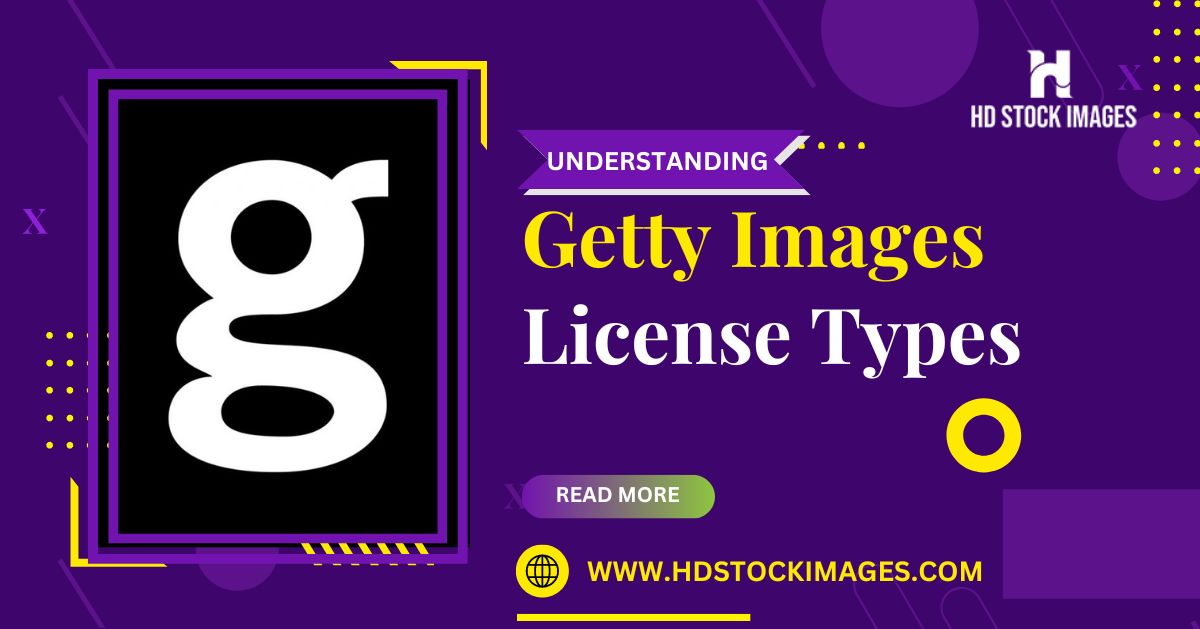Getty Images is a powerhouse in the world of visual content, providing a treasure trove of high-quality images and videos for various uses. Whether you’re a blogger, a marketer, or a designer, understanding Getty Images’ licensing fees is crucial to making the right choice for your project. These fees can vary based on how you intend to use the images—commercial, editorial, or personal use. Let’s dive into the intricacies of
Types of Licensing Available

When it comes to Getty Images, they offer two primary types of licensing: royalty-free and rights-managed. Each has its own characteristics, benefits, and costs. Let's break them down.
1. Royalty-Free Licensing
Royalty-free licenses are quite popular because they allow you to pay a one-time fee for a wide range of uses without worrying about ongoing royalties. Here’s what you need to know:
- Flat Rate: You pay a single fee per image or video, making budgeting easier.
- Flexible Use: Once purchased, you can use it across various platforms and formats.
- No Expiration: You don’t need to renew your license after a certain period.
However, you should be mindful of the restrictions that might apply, such as not using the content for resale or in products designed for resale without additional permissions.
2. Rights-Managed Licensing
Rights-managed licenses are more complex and often tailored for specific needs, offering a license based on the intended use. Here’s how it works:
- Usage-Specific Fees: The cost is determined by factors like the type of publication, geographical reach, and duration.
- Exclusive Use: In many cases, you gain exclusivity for a certain period, which can help maintain originality.
- Defined Terms: You’ll need to specify things like resolution, placement, and duration upfront.
Although this option could be more expensive due to its specialized nature, it often ensures that you're getting exactly what you need without stepping on anyone else's toes.
Also Read This: How to Download Getty Images Free of Charge
Factors Influencing Licensing Fees

When it comes to licensing fees for Getty Images, several key factors play a crucial role in determining how much you'll end up paying. Understanding these can help you navigate your budget effectively. Here are some of the primary factors that influence licensing fees:
- Type of Image: The category of the image can significantly affect pricing. Editorial images, for example, may cost different than commercial images due to their intended use.
- Usage Rights: The scope of usage you require—like social media posts, print ads, or merchandise—can change the fee structure. Licensing for worldwide rights usually incurs higher costs than local or limited rights.
- Duration of Use: How long you need the image plays a part too. A one-time use is generally cheaper than a long-term licensing agreement.
- Distribution Scale: If you're planning to distribute the image on a global scale, expect higher fees. Conversely, localized use is usually more budget-friendly.
- Customization and Exclusivity: Custom images or exclusive rights will cost more. If unique content is essential for your brand, be prepared to invest.
Understanding these factors can empower you as a buyer. Budget accordingly and weigh your options to ensure you get the best value for your investment in visual content.
Also Read This: How to Get iStock Videos for Free
Typical Costs for Licensing Getty Images
The cost of licensing images from Getty can vary widely based on different factors. Having a ballpark figure in mind can help you make informed decisions. Here's a rough overview of typical costs you might encounter:
| Image Type | Price Range |
|---|---|
| Editorial Images | $100 - $500 |
| Commercial Images | $150 - $1,200 |
| Premium Images | $300 - $2,500+ |
| Video Clips | $150 - $1,800 |
Keep in mind that these prices are approximate and might vary based on specific licensing agreements and promotional offers. It's always worth checking the Getty Images website for the latest pricing and subscription options. Whether you're a small business or a large corporation, there's an array of options to fit different budgets. Remember, investing in high-quality visuals can pay off in your marketing efforts!
Also Read This: Legally Using Getty Images in Your Projects
5. How to License Images from Getty
Licensing images from Getty is a straightforward process, but it's essential to grasp the various steps involved to ensure you're getting the images you need without crossing any legal boundaries. So, let’s break it down!
First off, you’ll want to visit the Getty Images website. Once there, you can start by using the search bar to find the specific images you're interested in. You can utilize various filters to narrow down your search, such as orientation, image type (e.g., photo, illustration, video), and even the color scheme.
Once you've selected the images you like, click on them to access their respective licensing information. This is where you can get to know the terms of use, such as:
- Rights Managed (RM): These fees can vary based on usage, ensuring you pay a fair price depending on how and where you plan to use the image.
- Royalty-Free (RF): A one-time fee usually allows for unlimited use, as long as you adhere to the stipulated guidelines.
After deciding which images to license, you’ll have the option to select a licensing plan that meets your needs. Follow the prompts to add images to your cart, and proceed to checkout. You'll need to create an account if you don't already have one, and then you can finalize your payment.
Remember, it’s key to keep a close eye on the licensing agreements to make sure you're fully compliant with the usage regulations.
Also Read This: Enhance Your Content Productivity With This Game-changing Instagram Thumbnail Grabber
6. Use Cases and Their Associated Fees
Understanding the specific use cases associated with Getty Images can really help you make informed decisions on which images to license, and at what costs. The fees can vary significantly depending on how you plan to use the images. Let’s dig into the most common scenarios:
| Use Case | Associated Fees |
|---|---|
| Website or Blog Usage | Typically starts at around $150 for standard images |
| Print Advertising | Can range from $200 to $1,000, depending on circulation and usage |
| Television/Film Production | Fees can go from $500 to $5,000, depending on the scope and duration |
| Social Media Posts | Usually around $50 to $300 per image |
| Merchandising | Can range from $1,000 to even $10,000 or more based on exclusivity |
Keep in mind that these fees are general estimates and can fluctuate based on factors like image popularity, exclusivity, and the market at the time. So, always check Getty’s site for the most accurate information! And remember, proper licensing not only protects you but also supports the artists behind the stunning visuals you love.
Also Read This: How to Put Two Images Side by Side
7. Alternatives to Getty Images
When it comes to stock images, Getty Images is a well-known name, but it's not the only option out there. If you’re exploring alternatives, you’ll be pleased to discover several platforms that offer a variety of images, often at a lower cost or under different licensing models. Here are some popular alternatives to consider:
- Shutterstock: Known for its vast library, Shutterstock offers millions of high-quality images, videos, and music tracks. They have flexible subscription plans tailored to different needs.
- Adobe Stock: This service integrates seamlessly with Adobe Creative Cloud applications. Adobe Stock is a great choice for those already in the Adobe ecosystem, as it offers premium images without leaving your design software.
- Unsplash: If you’re looking for free high-resolution images, Unsplash boasts a community of photographers who contribute their work. Although the selection might be more limited, the quality is consistently high.
- iStock: Owned by Getty Images, iStock provides budget-friendly options for consumers. With various subscription plans and credit-based purchases, you can choose what works best for your project.
- Canva: While primarily a design tool, Canva also has a library of stock images and templates. You can find ready-made layouts along with images that suit various personal or professional needs.
Each platform has its pros and cons, so it's important to assess what you really need in terms of image quality, licensing options, and budget. Finding the right alternative could save you money while still meeting your creative needs!
8. Conclusion: Making the Best Choice for Your Needs
Choosing the right stock images and understanding licensing fees can be daunting, but with the right knowledge, you can navigate these waters with ease. The key takeaway is that there's no one-size-fits-all solution. Your choice largely depends on:
- Project Requirements: Define your needs clearly. Are you looking for images for social media, marketing, or a corporate presentation? This influences the type of images and licensing you might need.
- Budget: Determine how much you’re willing to spend. While Getty Images offers premium quality, there are plenty of other cost-effective alternatives out there.
- Usage Rights: Pay attention to licensing agreements. Some platforms might grant more flexibility in usage than others, so choose a resource that aligns with how you intend to use the images.
- Quality vs. Variety: Consider whether you prioritize high-quality images over a broad selection. Different platforms might excel in one area but not the other.
In the end, the goal is to find imagery that not only resonates with your audience but also aligns with your budget and licensing needs. By conducting thorough research and evaluating your requirements, you can make the best choice that elevates your project to the next level!
 admin
admin








